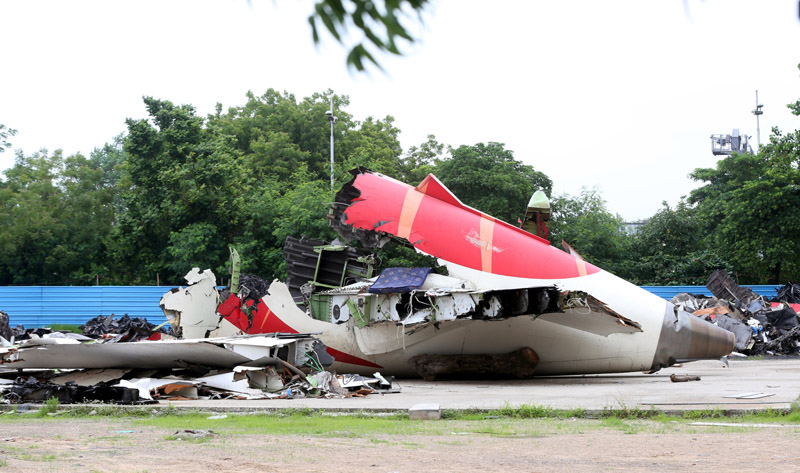Seconds before Air India flight 171 crashed while ascending from Ahmedabad, the fuel control switches of both its engines were cut off, a preliminary investigation report said on Saturday, suggesting a catastrophic pilot error in the cockpit of the Boeing 787 Dreamliner.
The Airlines Pilots Association of India raised the issue with the report, saying the investigation is “shrouded in secrecy,” appears to be biased against the pilot and has come to a conclusion hastily.
A 15-page preliminary investigation report into the disaster revealed fuel-control switches of the two engines moved from the “run” to the “cutoff” position, within the space of one second, leading to immediate loss of altitude.
In the cockpit voice recording, one pilot is heard asking the other why he cut off the fuel. The other denied having done so.
The report by Aircraft Accident Investigation Bureau (AAIB), released early on Saturday, neither concluded any reason for the switches moving nor apportioned explicit blame for the crash.
It also did not identify the pilots in the voice recording. But it also said no fault was found in the aircraft, leaving only the possibility of pilot error as the cause.
At the controls was First Officer Clive Kunder, 32, while Sumeet Sabharwal, a veteran with 30 years of experience at Air India, was the senior cockpit occupant in command monitoring the flight.
The report, however, referenced a 2018 airworthiness bulletin by the US Federal Aviation Administration that said fuel switches had been installed on Boeing 737s, a smaller model, “with the locking feature disengaged”. The locking mechanism was similar on various Boeing aeroplane models, including certain 787s, it said.
Air India did not carry out inspections recommended in the 2018 FAA advisory on fuel control switch safety, as the bulletin was classified as “non-mandatory”, the report said.
It wasn’t immediately clear if this had any link to the accident. The report provided the first detailed account of the fateful 32 seconds between takeoff in Ahmedabad and the crash into a medical college hostel just outside the airport perimeter, killing all but one of the 242 onboard and another 19 on the ground in the deadliest aviation accident in a decade.
The report did not provide any clues to why and by whom the two fuel switches were moved to a cut-off position as the plane nosed into the air, starving the two engines of the thrust needed for the lift. It ruled out any bird hit or fuel contamination.
According to a chronology laid out in the report, both fuel cutoff switches moved from RUN to CUTOFF, one second apart, almost immediately after takeoff. Ram Air Turbine (RAT) pump was deployed to supply hydraulic power as both engines fell below the minimum idle rate.
About 10 seconds later, Engine 1 fuel cutoff switch moved to its so-called RUN position, followed by Engine 2 four seconds later.
The pilots managed to relight both engines, but only Engine 1 recovered while Engine 2 failed to build up enough power again to reverse deceleration. One of the pilots issued a “Mayday, Mayday, Mayday” distress call, but before air traffic controllers could get a response about what had gone wrong, the plane crashed just outside the Ahmedabad airport boundary having grazed some trees before plunging into a hostel packed with students.
The time between the takeoff and the crash was only 32 seconds. The preliminary report recommended no action for now for the operators of Boeing 787-8 planes. In a statement, Air India said that it “stands in solidarity with the families and those affected” and “[continues] to mourn the loss” of those killed in the accident.
Air India said it was “working closely with stakeholders, including regulators” and “continue to fully cooperate with the AAIB and other authorities as their investigation progresses.”
On its part, Boeing said: “Our thoughts remain with the loved ones of the passengers and crew on board Air India Flight 171, as well as everyone affected on the ground in Ahmedabad. We continue to support the investigation and our customers.”
The US National Transportation Safety Board noted that there were no recommended actions in the report aimed at operators of Boeing 787 jets or the GE engines.
The ill-fated flight was commanded by Sumeet Sabharwal, 56, a veteran with 30 years of experience at Air India. He had logged 15,638 flying hours, including 8,596 on the Boeing 787. He was also an Air India instructor. His co-pilot was Clive Kunder, 32, who had 3,403 hours of total experience, with 1,128 hours on the Dreamliner.
Kunder was the pilot flying, while Sabharwal was the pilot monitoring.
The crew had passed pre-flight breathalyser tests and were seen at the gate on CCTV before they took off, the report adds.
The June 12 accident was India’s worst aviation disaster in almost three decades and the industry’s deadliest in 11 years, as well as the first fatal accident involving a Boeing Dreamliner.
The investigation was conducted with assistance from the UK’s Air Accident Investigation Branch and the US National Transportation Safety Board.
Aviation experts have said it is difficult for pilots to inadvertently move the fuel switches, as there is a little mechanical gate built into the switch. Switches need to be lifted up over this little gate to shut off supply. They also asked why the report made no reference to cockpit camera footage.
Fuel switches are devices that regulate the flow of fuel into the engine of an aeroplane. Pilots use them to start or shut down engines on the ground or during a flight in case of an engine failure. They are spring-loaded to remain in position. To change fuel supply, a pilot has to first pull the switch up and then move it from RUN to CUTOFF or vice versa.
“The aircraft achieved the maximum recorded airspeed of 180 Knots IAS at about 08:08:42 UTC (13.38 IST) and immediately thereafter, the Engine 1 and Engine 2 fuel cutoff switches transitioned from RUN to CUTOFF position one after another with a time gap of 01 sec,” the report said.
As per the report, the engine N1 and N2 began to decrease from their take-off values as the fuel supply to the engines was cut off.
“In the cockpit voice recording, one of the pilots is heard asking the other why did he cutoff. The other pilot responded that he did not do so,” it said.
Almost immediately after the plane lifted off the ground, CCTV footage shows a backup energy source called a ram air turbine had deployed, indicating a loss of power from the engines.
The report provided only a limited picture of the interaction between the two pilots in the flight deck.
The report said both fuel switches were found in the run position at the crash site and that there had been indications of both engines relighting before the low-altitude crash.
It said the aircraft took off at 08:08:39 UTC (13:38:39 IST) and at about 08:09:05 UTC (13:39:05 IST) one of the pilots transmitted ‘MAYDAY MAYDAY MAYDAY’.
“The ATCO (Air Traffic Controller) enquired about the call sign. ATCO did not get any response but observed the aircraft crashing outside the airport boundary and activated the emergency response,” the report said. (PTI)
Timeline of crash
Here is a look at the sequence of events leading to the deadly crash:
11:17 Hrs IST: Air India Dreamliner VT-ANB lands in Ahmedabad from New Delhi, operating as flight AI423
13:13:00 Hrs: Aircraft requests pushback and start up
13:13:13 Hrs: ATC approved pushback
13:16:59 Hrs: ATC approved start up.
13:18:38 Hrs: Aircraft departs from Bay 34 at Ahmedabad’s Sardar Vallabhbhai Patel International Airport
13:19:12 Hrs: ATC queried if the aircraft required the full length of the runway. The aircraft confirmed the requirement of full length of Runway 23.
13:25:15 Hrs: Aircraft requests taxi clearance, which was granted by air traffic control (ATC)
13:26:00 Hrs: Aircraft taxis to Runway 23 via Taxiway R4, backtracked and lined up for take-off
13:32:03 Hrs: Aircraft transferred from ground to tower control
13:33:45 Hrs: Aircraft instructed to line up on the Runway 23
13.37:37 Hrs: ATC clears take-off from Runway 23
13.37:37 Hrs: Takeoff roll starts
13:38:39 Hrs: Liftoff from runway
13:38:42 Hrs: Maximum speed of 180 knots reached
Immediately thereafter, both Engine 1 and Engine 2 fuel cutoff switches move from RUN to CUTOFF positions, one second apart. Engines begin to slow as fuel supply is cut off.
Ram Air Turbine (RAT) deployed during the initial climb immediately after lift-off.
One pilot is heard asking the other why he cut off fuel. The other answers that he has not done so
13:38:47 Hrs: Both Engine N1 and N2 drop below minimum idle speed. The RAT’s pump begins supplying hydraulic power.
13:38:52 Hrs: Engine N1 fuel cutoff switch moves to RUN from CUTOFF
13:38:56 Hrs: Engine N2’s fuel cutoff switch too rest to RUN
Both engines relight, and Engine 1 begins to recover. Engine 2 is unable to reverse deceleration
13:39:05 Hrs: One of the two pilots issues a distress “MAYDAY, MAYDAY, MAYDAY” call
13:39:11 Hrs: Data recording from the aircraft stops
13:44:44 Hrs: Fire tenders leave airport premises for rescue and firefighting(PTI)







